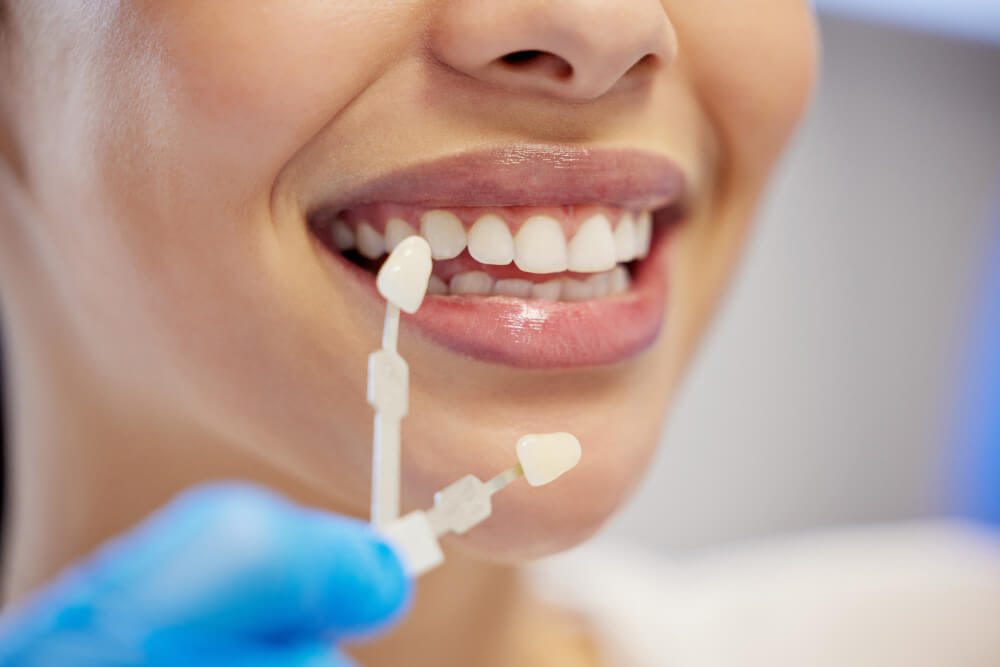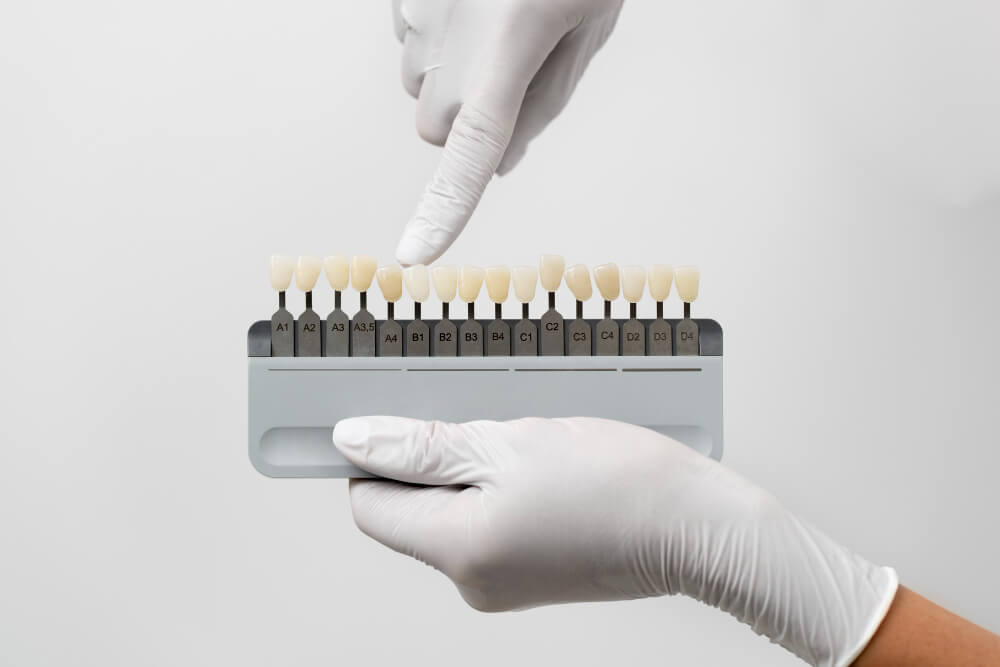Shaved Teeth for Veneers: Do They Need to Be Filed Down?

The quest for the perfect smile has taken on new dimensions in cosmetic dentistry. With the introduction of dental veneers, particularly composite and porcelain veneers, people can now more effectively address issues like broken or discoloured teeth.
However, a fundamental question remains: How much must our natural teeth be modified to achieve that desired Hollywood smile?
Understanding Dental Veneers
Teeth veneers are thin shells, usually made from porcelain or composite resin, designed to enhance the appearance of your smile. They can address slightly crooked teeth, discolouration, or minor shape corrections.
But before diving into the intricacies of teeth shaving, let’s explore the types of veneers available.
Porcelain Veneers: These are stain-resistant, custom porcelain shells crafted in a dental laboratory to fit over the existing natural teeth. They mimic the light-reflecting properties of real teeth, giving them a more natural look.
Composite Resin Veneers: Typically applied in a single appointment at the dentist’s office, composite veneers are made from composite resin applied directly to the tooth surface and sculpted according to the requirements.
Composite Resin vs Porcelain: The Chemistry Behind the Choice
The two primary veneer materials, composite resin and porcelain, boast unique chemical compositions and properties that influence their suitability for different applications, including whether or not you need shaved teeth.
Composite Resin
This material is a blend of plastic and fine glass particles. Its adaptable nature allows dentists to mould and sculpt it directly onto the tooth surface in the dentist’s chair. While cost-effective and requiring less invasive preparation, composite resin veneers tend to be less resistant to staining than their porcelain counterparts.
Porcelain
Derived from heated, refined clay, porcelain veneers are famed for their strength, translucence, and stain resistance. The material closely mimics the reflective properties of natural teeth. However, they often require some shaved teeth to ensure a proper fit.
Preparing the Natural Teeth for Veneers
One critical aspect of the veneer procedure is tooth preparation, often called “tooth shaving” or “teeth filing.” This process involves removing tooth enamel to ensure the veneer fits snugly and looks natural.
Traditional Veneers
These usually require removing a small amount of the existing tooth structure. The shaving ensures the porcelain veneer bonds well and aligns perfectly with the surrounding teeth, thus preventing an unnatural gum line or bulky appearance.
Minimal Preparation Veneers
Advances in veneer technology have introduced ultra-thin porcelain veneers that require little or no natural tooth preparation. These thinner veneers preserve a more natural tooth structure, making them an attractive option for many.
The amount of tooth enamel removed varies depending on the type of veneer and the patient’s specific needs. During the initial consultation, your Northbridge dentist will assess how many teeth need to be shaved and to what extent based on the patient’s desired aesthetics.
Why is Tooth Shaving Necessary?
Shaving teeth for veneers is primarily about achieving the desired aesthetics and ensuring the longevity of the veneer. By slightly reducing the tooth surface:
- Fit and Function: Veneers can fit seamlessly over the existing teeth without appearing bulky or unnatural.
- Bonding Strength: Removing a small portion of the enamel enhances bonding, ensuring the veneer adheres firmly.
- Aesthetic Alignment: If teeth are crooked or overlap, slight shaving can create a more even appearance, ensuring the new cosmetic smile looks natural and beautiful.
Risks and Considerations
Like all dental procedures, preparing teeth for veneers comes with its considerations:
- Permanent Procedure: Once teeth are shaved, they cannot revert to their original state. This commitment makes it crucial to consult extensively with a cosmetic dentist to understand the implications fully.
- Tooth Sensitivity: Removing enamel might cause temporary sensitivity to hot and cold. While this usually subsides, being aware of potential discomfort is essential.
- Underlying Issues: If there’s hidden tooth decay or if the shaving process exposes the tooth’s inner layers, further dental treatment, like a root canal treatment, may be required.
- Longevity of Veneers: While veneers are durable, they may need replacement after a decade or two. Proper care, coupled with good oral hygiene, can extend their lifespan.
The Veneer Process: From Consultation to Completion
- Initial Consultation: The journey to a new smile begins with a thorough assessment. Here, the cosmetic dentist examines the teeth, discusses desired outcomes, and recommends the type of veneer most suitable.
- Tooth Preparation: The teeth are prepared based on the veneer chosen. This might involve local anaesthetic to ensure comfort during the shaving process.
- Impression Making: A teeth mould is made and sent to a dental lab after preparation. Dental technicians craft custom veneers for porcelain veneers to fit the teeth perfectly.
- Temporary Veneers: Temporary veneers may be installed to shield the teeth prepped while the custom veneers are being made.
- Veneer Placement: Once the custom veneers are ready, they are checked for fit and colour. Any minor adjustments are made, and the veneers are bonded to the teeth with dental cement. The result? A beautiful, radiant smile.
Caring for Your Veneers
Though veneers are stain-resistant, maintaining a rigorous oral health routine is paramount. Regular brushing, flossing, and dental check-ups ensure the longevity of the veneers and the underlying natural teeth.
Avoiding excessive pressure (like biting nails) and refraining from using teeth as tools can also prevent unintentional veneer damage.
Advanced Veneer Technologies: A World Beyond Traditional Approaches
Modern advancements have improved the veneer process, reducing the need for extensive shaved teeth for veneers.
- Ultra-Thin Veneers: These veneers are as thin as contact lenses. Their super-thin nature means they can adhere to the existing teeth without significant reshaping.
- Laser Tooth Preparation: Some dental clinics are using lasers for tooth preparation. This method can be more precise, reducing the risk of damaging the tooth’s inner layers.
- Digital Smile Design: Some dentists use digital software to simulate the outcome of the veneer procedure. This allows patients to visualise their new smile before committing to the procedure.
Addressing Concerns: What Potential Patients Should Know
While veneers offer transformative results, potential patients often harbour concerns. Let’s address some of these:
- Natural Feel: Many wonder if veneers will feel like their real teeth. Over time, most people acclimatise, and the veneers think no different from their natural teeth.
- Durability: With proper care, porcelain veneers can last 10-15 years or even longer. Composite resin veneers, which are less robust, may last 5-7 years.
- Reversibility: As previously mentioned, most veneer procedures, especially those requiring tooth reduction, are permanent. Once the tooth enamel is removed, it can’t be replaced. However, if veneers ever chip or become damaged, they can usually be repaired or replaced.
- Dietary Restrictions: While veneers are strong, avoiding habits like nail biting or opening bottles with teeth is wise. It’s also best to be cautious with tough foods or candies that could cause damage.

Veneers Beyond Cosmetics: Therapeutic Uses
While veneers are primarily associated with cosmetic enhancements, they also possess therapeutic benefits:
- Protective Barrier: Veneers can act as a protective shield for teeth with eroded enamel, preventing further wear.
- Reinforcement: Veneers can provide added strength for cracked or weakened teeth, much like a splint.
- Closing Gaps: Besides mere aesthetic benefits, closing gaps between teeth with veneers can also prevent food particles from getting trapped, reducing the risk of decay.
Making a Choice: Key Factors to Consider
Opting for veneers is a significant decision. Here are some factors to ponder:
- Cost: Porcelain veneers are more costly than composite resin veneers due to their durability and the intricacy of their fabrication process.
- Maintenance: While veneers are relatively low maintenance, routine dental check-ups are crucial to ensure their longevity and the health of the underlying teeth.
- Alternative Treatments: In some cases, orthodontic treatment might be a more suitable long-term solution for gaps or misalignments. It’s vital to discuss all potential options with a cosmetic dentist.
To Sum Up
In conclusion, while the thought of teeth being shaved might seem daunting, the outcomes often justify the process. With advancements in cosmetic dentistry, the veneer process has become more streamlined, ensuring patients can achieve their dream smile with minimal discomfort.
As with any dental treatment, thorough research and consultation with a trusted cosmetic dentist are vital.
Dental Veneers in Northbridge
Ready to start your smile makeover journey? Contact My Local Dentists today and let our team of professionals guide you towards your most radiant smile yet.
Call your Northbridge dentist today at (02) 8318 5966.
Visit us at Shop 20A Northbridge Plaza, 79-113 Sailors Bay Road in Northbridge.
